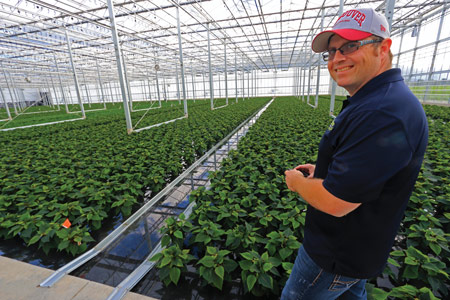10/29/2014
Ebb & Flood Without Concrete
Chris Beytes
Photography by Chris Beytes

Head Grower Rob O’Hara uses his smartphone to start the irrigation cycle on a bay of poinsettias growing on an Erfgoed Floor at Rainbow Greenhouses in Chilliwack, British Columbia.
Developed first for outdoor growers by Erfgoed of Moerkapelle, the Netherlands (
www.erfgoed.nl), Erfgoed’s cultivation floor, or “Erfgoed Floor” as they call it, is unique in that it’s a flood floor without concrete. Instead, the floor is constructed of a layer of compacted gravel with an impermeable membrane below and a capillary mat above, capped off by ground cloth. Distribution pipes are buried in the gravel in similar fashion to concrete floors.
The big difference is how the floor fills and drains. Concrete ebb & flood floors have a V profile, and they fill and drain from a line of drain holes at the bottom of the V, which means that those plants nearest the holes sit in water longer than those near the edges. Also, water remains in low spots, potentially causing root rot
problems.
The Erfgoed Floor is completely flat. It floods all at once, with the water rising straight up through the gravel. Drainage occurs the same way, straight down. That means every plant is irrigated for the same length of time. And if low spots do develop, plants will never sit in puddles since the entire floor acts as a drain.
“To me, the number one thing was to avoid plants ever sitting in water,” says Rob of the decision to install 2.5 acres of Erfgoed Floor as part of Rainbow’s 8.5 acre, $8.5 million expansion. With his traditional concrete flood floors, he’s had to resort to putting every poinsettia up on plastic disks because the floors have low spots that retain water.
An obvious benefit of the system is lower cost, as there’s no concrete. Rob also says Erfgoed claims some plant health benefits, since the gravel floor helps filter solids out of the water. A downside is transport: Since the gravel could be dented by standard cart wheels, they roll carts in on the metal tracks you see in the picture.
These are Rob’s first poinsettias on the floor. How do they grow on it?
“You’ll have to ask me in December,” he says.
GT